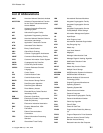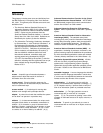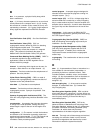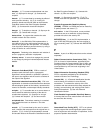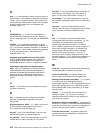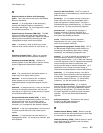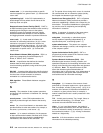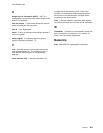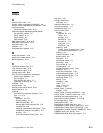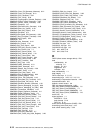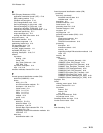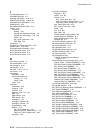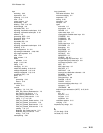CCA Release 2.54
reason code. (1) A value that provides a specific
result as opposed to a general result. (2) Contrast with
return code.
replicated key-half. In the CCA implementation, a
double-length DES key where the two halves of the
clear-key value are equal.
Resource Access Control Facility (RACF). RACF is
an IBM licensed program that enables access control by
identifying and verifying the users to the system,
authorizing access to protected resources, logging
detected unauthorized attempts to enter the system,
and logging detected accesses to protected resources.
return code. (1) A code used to influence the
execution of succeeding instructions. (A) (2) A value
returned to a program to indicate the results of an
operation requested by that program. (3) In the CCA
implementation, a value that provides a general result
as opposed to a specific result. (4) Contrast with
reason code.
Rivest-Shamir-Adleman (RSA) algorithm. RSA is a
public-key cryptography process developed by R.
Rivest, A. Shamir, and L. Adleman.
RS-232. A specification that defines the interface
between data terminal equipment and data
circuit-terminating equipment, using serial binary data
interchange.
RS-232C. A standard that defines the specific physical,
electronic, and functional characteristics of an interface
line that uses a 25-pin connector to connect a
workstation to a communication device.
RSA algorithm. Rivest-Shamir-Adleman encryption
algorithm.
S
security. The protection of data, system operations,
and devices from accidental or intentional ruin, damage,
or exposure.
security server. In the CCA implementation, the
functions provided through calls made to the security
API.
server. On a Local Area Network, a data station that
provides facilities to other data stations; for example, a
file server, a print server, a mail server. (A)
session. (1) In network architecture, for the purpose
of data communication between functional units, all the
activities that take place during the establishment,
maintenance, and release of the connection. (T)
(2) The period of time during which a user of a terminal
can communicate with an interactive system (usually,
the elapsed time between logon and logoff).
Session-Level Encryption (SLE). SLE is a Systems
Network Architecture (SNA) protocol that provides a
method for establishing a session with a unique key for
that session. This protocol establishes a cryptographic
key and the rules for deciphering and enciphering
information in a session.
string. A sequence of elements of the same nature,
such as characters, considered as a whole. (T)
subsystem. A secondary or subordinate system,
usually capable of operating independently of, or
asynchronously with, a controlling system. (T)
system administrator. The person at a computer
installation who designs, controls, and manages the use
of the computer system.
System Authorization Facility (SAF). SAF is a
program that provides access to the resource access
control facility or its equivalent.
Systems Network Architecture (SNA). SNA
describes logical structure, formats, protocols, and
operational sequences for transmitting information units
through, and controlling the configuration and operation
of, networks. Note: The layered structure of SNA
allows the ultimate origins and destinations of
information, that is, the end users, to be independent of
and unaffected by the specific SNA network services
and facilities used for information exchange.
T
throughput. (1) A measure of the amount of work
performed by a computer system over a given period of
time; for example, number of jobs per day. (A) (I) (2) A
measure of the amount of information transmitted over
a network in a given period of time; for example, a
network’s data-transfer-rate is usually measured in bits
per second.
TLV. A widely used construct, Tag, Length, Value, to
render data self-identifying. For example, such
constructs are used with EMV smart cards.
token. (1) In a Local Area Network, the symbol of
authority passed successively from one data station to
another to indicate the station is temporarily in control of
the transmission medium. (T) (2) A string of characters
treated as a single entity.
trace file. A file that contains a record of trace
information for the selected processing.
X-8 IBM 4758 CCA Basic Services, Release 2.54, February 2005




